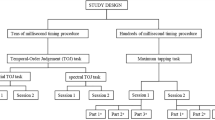Abstract
Synchronising our actions with external events is a task we perform without apparent effort. Its foundation relies on accurate temporal control that is widely accepted to take one of two different modes of implementation: explicit timing for discrete actions and implicit timing for smooth continuous movements. Here we assess synchronisation performance for different types of action and test the degree to which each action supports corrective updating following changes in the environment. Participants performed three different finger actions in time with an auditory pacing stimulus allowing us to assess synchronisation performance. Presenting a single perturbation to the otherwise regular metronome allowed us to examine corrections supported by movements varying in their mode of timing implementation. We find that discrete actions are less variable and support faster error correction. As such, discrete actions may be preferred when engaging in time-critical adaptive behaviour with people and objects in a dynamic environment.


Similar content being viewed by others
References
Aoki T, Francis PR, Kinoshita H (2003) Differences in the abilities of individual fingers during the performance of fast, repetitive tapping movements. Exp Brain Res 152:270–280
Aschersleben G (2002) Temporal control of movements in sensorimotor synchronization. Brain Cogn 48:66–79
Balasubramaniam R, Wing AM, Daffertshofer A (2004) Keeping with the beat: movement trajectories contribute to movement timing. Exp Brain Res 159:129–134
Elliott MT, Welchman AE, Wing AM (2008) MatTAP: a MATLAB toolbox for the control, analysis of movement synchronisation experiments. J Neurosci Methods. doi:10.1016/j.jneumeth.2008.10.002
Hogan N, Sternad D (2007) On rhythmic and discrete movements: reflections, definitions and implications for motor control. Exp Brain Res 181:13–30
Luck G, Sloboda J (2008) Exploring the spatio-temporal properties of simple conducting gestures using a synchronization task. Music Percept 25:225–239
Luck G, Toiviainen P (2006) Ensemble musicians synchronization with conductors gestures: an automated feature-extraction analysis. Music Percept 24:189–200
Marder E (2000) Motor pattern generation. Curr Opin Neurobiol 10:691–698
Neda Z, Ravasz E, Brechet Y, Vicsek T, Barabasi AL (2000) Self-organizing processes: the sound of many hands clapping. Nature 403:849–850
Pinheiro J, Bates D (2007) R: a language and environment for statistical computing (documentation). http://www.R-project.org
Pressing J (1998) Error correction processes in temporal pattern production. J Math Psychol 42:63–101
Repp BH (2000) Compensation for subliminal timing perturbations in perceptual-motor synchronization. Psychol Res 63:106
Repp BH (2002a) Automaticity and voluntary control of phase correction following event onset shifts in sensorimotor synchronization. J Exp Psychol Hum Percept Perform 28:410–430
Repp BH (2002b) Phase correction in sensorimotor synchronization: nonlinearities in voluntary and involuntary responses to perturbations. Hum Mov Sci 21:1–37
Repp BH (2003) Rate limits in sensorimotor synchronization with auditory and visual sequences: the synchronization threshold and the benefits and costs of interval subdivision. J Mot Behav 35:355–370
Repp BH (2005) Sensorimotor synchronization: a review of the tapping literature. Psychon Bull Rev 12:969–992
Robertson SD, Zelaznik HN, Lantero DA, Bojczyk KG, Spencer RM, Doffin JG et al (1999) Correlations for timing consistency among tapping and drawing tasks: evidence against a single timing process for motor control. J Exp Psychol Hum Percept Perform 25:1316–1330
Schaal S, Sternad D, Osu R, Kawato M (2004) Rhythmic arm movement is not discrete. Nat Neurosci 7:1136–1143
Spencer RMC, Zelaznik HN, Diedrichsen J, Ivry RB (2003) Disrupted timing of discontinuous but not continuous movements by cerebellar lesions. Science 300:1437–1439
Spencer RMC, Verstynen T, Brett M, Ivry R (2007) Cerebellar activation during discrete and not continuous timed movements: an fMRI study. NeuroImage 36:378–387
Stevens LT (1886) On the time sense. Mind 11:393–404
Turvey MT (1977) Preliminaries to a theory of action with reference to vision. In: Shaw R, Bransford J (eds) Perceiving. acting and knowing. Erlbaum, Hillsdale, pp 211–265
Vorberg D, Schulze HH (2002) Linear phase-correction in synchronization: predictions, parameter estimation, and simulations. J Math Psychol 46:56–87
Vorberg D, Wing AM (1996) Modeling variability and dependence in timing. In: Heuer H, Keele SW (eds) Handbook of perception and action. Academic Press, London, pp 181–262
Wing AM, Kristofferson AB (1973) Response delays and the timing of discrete motor responses. Percept Psychophys 14:5–12
Zelaznik HN, Spencer RMC, Ivry RB (2002) Dissociation of explicit and implicit timing in repetitive tapping and drawing movements. J Exp Psychol Hum Percept Perform 28:575–588
Zelaznik HN, Spencer RMC, Ivry RB, Baria A, Bloom M, Dolansky L et al (2005) Timing variability in circle drawing and tapping: probing the relationship between event and emergent timing. J Mot Behav 37:395–403
Zivotofsky A, Hausdorff J (2007) The sensory feedback mechanisms enabling couples to walk synchronously: an initial investigation. J Neuroeng Rehabil 4:28
Acknowledgments
This work was supported by grants from the Biotechnology and Biological Sciences Research Council [C520620, EO09565]. The authors thank Dirk Vorberg and Hans-Henning Schultz for their comments on an earlier draft of the manuscript.
Author information
Authors and Affiliations
Corresponding author
Rights and permissions
About this article
Cite this article
Elliott, M.T., Welchman, A.E. & Wing, A.M. Being discrete helps keep to the beat. Exp Brain Res 192, 731–737 (2009). https://doi.org/10.1007/s00221-008-1646-8
Received:
Accepted:
Published:
Issue Date:
DOI: https://doi.org/10.1007/s00221-008-1646-8




